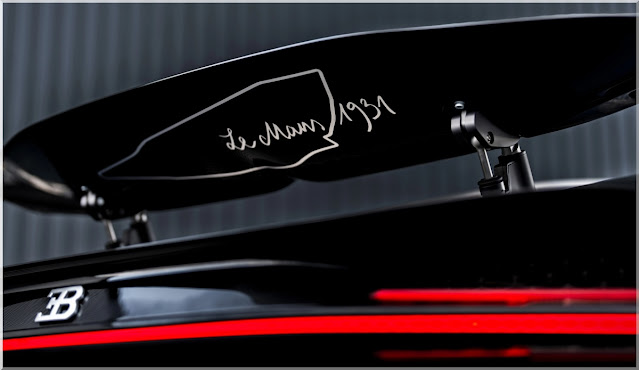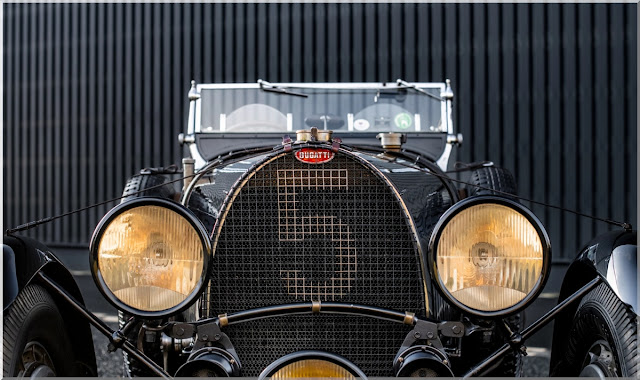How Bugatti Type 50S paved the way for its Le Mans glory
The Bugatti Type 50S was a pioneering creation that marked the brand's official factory debut at the legendary 24 Hours of Le Mans race in 1931. Although it did not win, it showed enormous potential and inspired future generations of Bugatti sports cars. The Type 50S also represented the pinnacle of Bugatti's large-capacity engine lineage, with a revolutionary five-liter supercharged eight-cylinder engine that produced around 250 horsepower. The Type 50S was a luxurious and elegant car that could compete with the best racing cars of its time. It was also a rare and valuable car, with only 65 units built. Today, the Type 50S is a highly regarded collectible and a piece of automotive history.
The design and features of the Type 50S
The Type 50S was derived from the celebrated Type 46, introduced in 1929 as a comfortable, refined road car. The Type 46 featured a long, low-slung body, a horseshoe-shaped radiator, and a 5.4-liter straight-eight engine that delivered 140 horsepower. The Type 46 was a success, with more than 400 units sold. However, Jean Bugatti, the son of founder Ettore Bugatti, wanted to create an even better and faster car based on the same chassis. He took inspiration from the Miller racing cars that competed in the 1929 Indianapolis 500 race, and as a result, in late 1930, the Type 50 was born.
The Type 50 significantly improved over the Type 46, with several essential upgrades. The most notable was the new engine, Bugatti's first engine with a dual overhead camshaft. The engine had a displacement of five liters and was equipped with a Roots-type supercharger that boosted its power to around 250 horsepower. The engine also had hemispherical combustion chambers and inclined valves, which improved its efficiency and performance. The engine was mounted on rubber blocks to reduce vibrations and noise. The Type 50 also had a four-speed manual gearbox, a De Ram hydraulic shock absorber system, and hydraulic brakes on all four wheels.
The Type 50 was designed with a luxurious and elegant appearance, which attracted wealthy car enthusiasts looking for a stylish ride. It featured a long hood and a low-slung body, giving it a sporty look. The horseshoe-shaped radiator dominated the front fascia, which was a signature element of Bugatti cars. The radiator was flanked by two large headlights, which were supported by a chromed horizontal bar connected to the front fenders' inner sides. The front fenders also had additional headlamps on top of them, which enhanced the car's visibility and aesthetics. The front bumper was made of metal and extended forward from the chassis, showing Bugatti's concern for safety.
The Type 50 had a short wheelbase of 3.1 meters, which limited its interior space and made it suitable for only two passengers. The car was available in two body styles: a coupe and a roadster. The coupe had a sloping roofline and a curved rear end, while the roadster had a removable soft top and a flat trunk lid. External coachbuilders, such as Gangloff, Vanvooren, and Figoni, mostly did the bodywork. The customers could choose from various colors and materials for the car's exterior and interior. The interior was luxurious and comfortable, with leather seats, a wooden dashboard, and a four-spoke steering wheel. The dashboard had several instruments, such as a speedometer, a tachometer, an oil pressure gauge, and a fuel gauge.
The racing history of the Type 50S
The Type 50 was a road car and a racing car. Jean Bugatti believed that the car had the potential to win the most grueling and prestigious motor race in the world: the 24 Hours of Le Mans. The race was held annually on a public road circuit near Le Mans, France. The race was a test of endurance, speed, and reliability, as the cars had to run for 24 hours non-stop, covering more than 4,000 kilometers. The race was also a showcase of the latest innovations and technologies in the automotive industry.
In 1931, Bugatti entered three Type 50 cars in the Le Mans race, marking the brand's official factory debut. The three vehicles were modified versions of the road car, with some changes to improve their performance and aerodynamics. The vehicles were designated Type 50S, where S stood for Sport. The Type 50S had a lighter and more streamlined body, with a lower roofline, a shorter windshield, and a tapered tail. The Type 50S also had a larger fuel tank, a reinforced chassis, and a more powerful engine with a higher compression ratio and a larger supercharger. The engine could produce up to 300 horsepower, making the Type 50S one of the fastest cars on the track.
The three Type 50S cars were painted entirely black rather than the traditional French racing blue. This was a subtle protest by Bugatti against the French government, which refused to sponsor the team. The black also gave the cars a menacing and mysterious look, contrasting with the other competitors' colorful and flashy vehicles. The three cars were driven by some of the best drivers of the time, such as Louis Chiron, Albert Divo, and Guy Bouriat. The vehicles had the numbers 1, 2, and 3 and were nicknamed "Black Bess," "Black Beauty," and "Black Prince."
The race started on June 13, 1931, at 4 p.m. The Type 50S cars showed their speed and power from the beginning, reaching over 200 km/h on the long straights. The vehicles also handled well on the corners, thanks to their balanced weight distribution and suspension system. The cars quickly took the lead and dominated the race for the first few hours. However, the race was not without challenges and difficulties. The cars had to deal with mechanical issues, such as overheating, tire wear, and brake failure. The vehicles also had to cope with the changing weather conditions, such as rain, fog, and darkness. The drivers had to endure the physical and mental fatigue of driving for long periods, with only brief breaks for refueling and repairs.
The race's most dramatic and tragic moment happened in the ninth hour, when car number 1, driven by Bouriat and Philippe Etancelin, suffered a tire blowout at high speed on the Mulsanne Straight. The car lost control and crashed into a ditch, killing Bouriat instantly and injuring Etancelin. The vehicle was destroyed, and they had to retire from the race. The accident shocked and saddened the Bugatti team and the spectators and cast a shadow over the rest of the race.
Car number 2, driven by Bugatti Chiron and Divo, continued to lead the race until the 16th hour, when it also had a tire failure on the same straight. The car managed to avoid a crash but had to stop for repairs. The vehicle lost several minutes and positions and was overtaken by the Alfa Romeo 8C 2300 of Lord Howe and Henry Birkin. Car number 3, driven by Marcel Lehoux and Jean-Pierre Wimille, also had problems with its brakes and gearbox and fell behind the other cars. The Bugatti team tried to catch up with the Alfa Romeo, but it was too late. The race ended on June 14, at 4 p.m., with the Alfa Romeo winning by a margin of 26 minutes over the Bugatti number 2, which finished second. The Bugatti number 3 finished fifth, behind two other Alfa Romeo.
The 1931 Le Mans race was a bitter disappointment for Bugatti, who hoped to win its first victory at the event. The race also marked the end of the Type 50S as a racing car, as Bugatti decided to focus on other models, such as the Type 51 and the Type 55. The Type 50S had shown its potential and prowess, but it had also revealed its flaws and limits. The Type 50S had been Bugatti's brave and bold attempt to challenge the best racing cars of its time, but it had also been a costly and tragic experiment.
The limited production and value of the Type 50S
The Type 50S was a rare and exclusive car on the track and on the road. The car was produced in minimal numbers, with only 65 units built between 1930 and 1934. The vehicle was also costly, costing around 120,000 francs at the time, equivalent to about $500,000 today. The car was reserved for the wealthy and the elite, who could afford its high price and appreciate its high quality. The vehicle was also personal and customized, as each customer could choose the body style, the color, the material, and the details of their vehicle. The car was a reflection of the owner's taste and personality and a symbol of their status and prestige.
The famous and notable owners of the Type 50S
The Type 50S car was admired and desired by many but owned by few. Some of the famous and notable owners of the Type 50S were:
- King Leopold III of Belgium bought a coupe with a Gangloff body in 1932. He used the car for official and private trips and racing. He participated in several events, such as the Grand Prix of Spa, the Grand Prix of Dieppe, and the 24 Hours of Spa. He also lent the car to his friend and racing driver, Robert Benoist, who won the Grand Prix of Comminges with it in 1933. The car was later sold to a French collector, who restored it and displayed it at various shows and rallies.
- Peter Mullin is a renowned car collector and founder of the Mullin Automotive Museum in California. He acquired a roadster with a Million-Guiet body in 1985, one of the three cars raced at Le Mans in 1931. The car had the number 3 and was nicknamed "Black Prince." The car had a remarkable history, as it was owned by several prominent figures, such as the Maharaja of Jaipur, the Aga Khan, and the French Resistance leader, Jean Moulin. The car was also involved in a famous robbery in 1962 when it was stolen from a Paris garage and later recovered. The car was restored to its original condition and won several awards, such as the Best of Show at the Pebble Beach Concours d'Elegance in 2003.
- Dr. Peter Williamson, a neurologist and a Bugatti enthusiast. He purchased a coupe with a Vanvooren body in the early 1970s and gave it to his father, Norris, as a birthday present. Mr. Williamson Sr. had the car restored and finished in Dartmouth Green as he graduated from Dartmouth. When he passed away, Peter and Susan Williamson assumed ownership. The vehicle was part of their impressive Bugatti collection, which included 12 models and was displayed at their Lyme, New Hampshire, private museum. The car was also shown at several events, such as the Pebble Beach Concours d'Elegance, where it won the French Cup in 2003. The car was sold at auction in 2008 for $2.75 million.
These are just some examples of the owners of the Type 50S who cherished and preserved this rare and valuable car. Today, the Type 50S is a highly regarded collectible and a piece of automotive history. It is a testament to Bugatti's vision and innovation, as well as its racing heritage and legacy. The Type 50S was a pioneering creation that paved the way for Bugatti's Le Mans glory.






